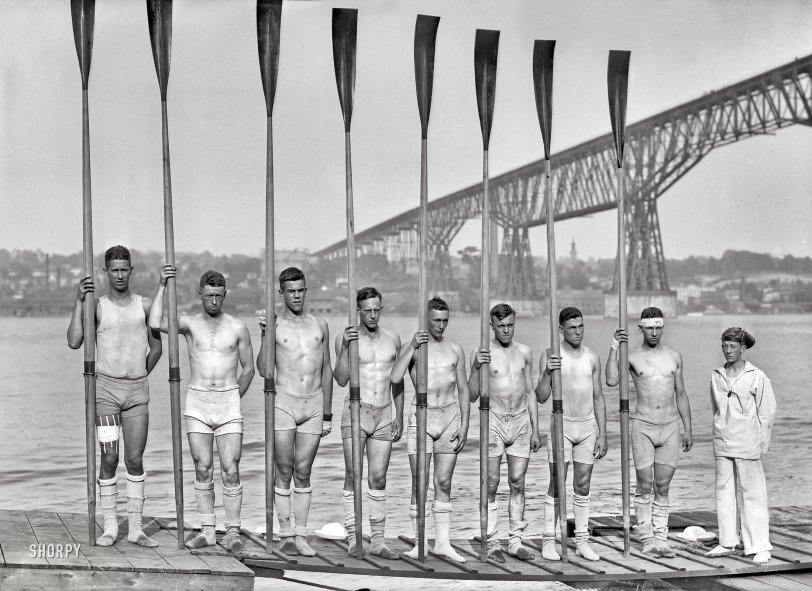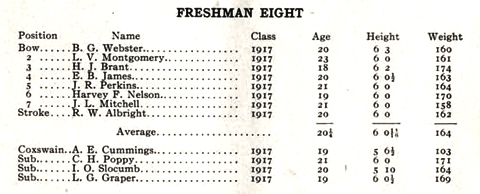


Framed or unframed, desk size to sofa size, printed by us in Arizona and Alabama since 2007. Explore now.
Shorpy is funded by you. Patreon contributors get an ad-free experience.
Learn more.

- Freeze Frame
- Texas Flyer wanted
- Just a Year Too Soon
- WWII -- Replacing men with women at the railroad crossing.
- Yes, Icing
- You kids drive me nuts!
- NOT An Easy Job
- I wonder
- Just add window boxes
- Icing Platform?
- Indiana Harbor Belt abides
- Freezing haze
- Corrections (for those who care)
- C&NW at Nelson
- Fallen Flags
- A dangerous job made worse
- Water Stop
- Passenger trains have right of way over freights?
- Coal
- Never ceases to amaze me.
- Still chuggin' (in model form)
- Great shot
- Westerly Breeze
- For the men, a trapeze
- Tickled
- Sense of loneliness ...
- 2 cents
- Charm City
- What an Outrage
- Brighton Park
Print Emporium
Ready to Row: 1914

June 1914. Poughkeepsie, New York. "Wisconsin freshmen on Hudson River." More rowers from the heyday of the Poughkeepsie Regatta. View full size.
Long Oars, Low Bridge
Splunge, What amazes me is that the oars are taller than the bridge, and I don't see any "Low Bridge" warning signs!
Wuthering Heights
(Actually, it doesn't look to be all that windy. I just liked the title.) OK, Groucho aroused me from my laziness. My last diagram simply applied linear comparisons and I inferred the perspective correction. That'll teach me to make assumptions - it turns out there was more skew than I thought. The photo below has had perspective correction applied until the distance between each oar's handle and its collar is the same (green bars). That should normalize the heights of everyone involved. I then applied the "measure the guy on the left and compare his height to everyone else" method (red bars). While that does narrow the spectrum, the difference between the tallest and shortest (cyan bar) is still a good six inches by my reckoning (as compared to the size of the gentleman's head). The cox looks to be a good ten or eleven inches shorter than the guy on the left, but that's not surprising.
I'll shut up now, and return to my omphaloskepsis. (At least until the next irresistible photo gets posted, in 3, 2, 1...)
[edit: knowing almost nothing about crew/sculling/sweeping, I consulted the US Rowing Rules for 2012. While there's no telling how close these rules are to those that were in effect in 1914, I noted that the only rules pertaining to oars related solely to their thickness, not their length. Thus, under my reading of today's rules, every oar could be a different length (although what advantage that might confer eludes me). That said, I assume the pictured oars are at least approximately the same length, at least from handle to collar. I also assume I'll soon be corrected and/or chastised by someone far more knowledgeable.]

Heights again
Splunge,
I tried your method on the oar handles (minus the black paddle part). Either every oar is a different length getting short from the left or perspective makes more difference than you think!
(Does this make me more bored than you?)

Say cheese!
Now if these fellows would have smiled like the last group, there'd of been just as many cuties.
The Heights (of Fastidiousness and Boredom)
Yes, the dock/gangplank sags. Yes, the camera is slightly closer to the fellow on the left. Still, there is a large variation in heights. Below is a comparison based on the leftmost rower; the red lines represent his height aligned with the heels of each of his teammates (it's cut & pasted, so it's identical). Even accounting for the skew from the camera angle, the guy on the left has about a foot on the shortest rower.

Poughkeepsie Bridge
I'm more interested in the bridge in the background. I suppose that is what carried the freight between New England and Maybrook, NY, until it burned, under Conrail ownership.
Note to Mr_Softy
The men's height difference can be explained by the downward slope from the higher left-hand dock to sagging planking and onto the lower floating right-hand pontoon or dock.
Fourth from left
I didn't know Geoffrey Rush was that old, or that he attended Wisconsin.
The Opening to the Walkway Over the Hudson
And, yes, I have heard from ‘’old timers’’ there were indeed crew quarters over
on the west bank of the Hudson.

Male Support
@MrSofty: The guys on the right are on the sagging part of the gangplank.
Freshman 8
No way these are the starters listed in that program, all listed at 6'0"-6'3". The difference between the rowers on the far left and far right looks to be almost a foot!
Word origins
I never knew the origins of the term "crew socks" until I saw such a graphic historical display. This photo should be used to illustrate the term in all dictionaries.
crew sock
noun
Usually, crew socks . short, thick casual socks usually ribbed above the ankles.
Re: Faster than the JVs
They're carrying less baggage.
My OCD
wants to swap the 2nd and 3rd chaps from the left. And 5th from the left is sucking in the gut he does not even have.
Faster than the JVs
Returning to the June 26, 1914 IRA Race Program, the Wisconsin Freshmen 8 were in the second two-mile race of the day, against Cornell, Columbia, Pennsylvania and Syracuse, and finished last, with a time of 10 minutes, 58 seconds, against Cornell's winning time of 10 minutes, 26 seconds. If the times recorded in the 1914 program are correct, all five freshman teams rowed faster that afternoon than the Junior Varsity teams had done on the same course less than an hour before, in which the winning time was 11 minutes, 15 3/5 seconds. Here's the Wisconsin Freshmen 8 list.

Rowing apparently doesn't put hair on your chest
Is it coincidence that there is nary a hirsute rower among them, or is it possible they shaved their chests like swimmers? (Did swimmers do that then?)
I’m little confused
That’s Poughkeepsie behind these fellows. Now, the boat houses of my memory were on the Poughkeepsie shore. Perhaps there were some crew facilities on this side of the Hudson; this was long before my time. But even here you can see things look a bit shabby.
Suprising
You know,when you look at pics from the Edwardian era do you ever think of the people as particularly built, especially with regard to abs and thighs? But darn if they aren't. Another thing you also don't expect is such revealing, shall we say, "profiles" as well.
The jockstrap
I suppose male support was invented for times just like these.
























On Shorpy:
Today’s Top 5